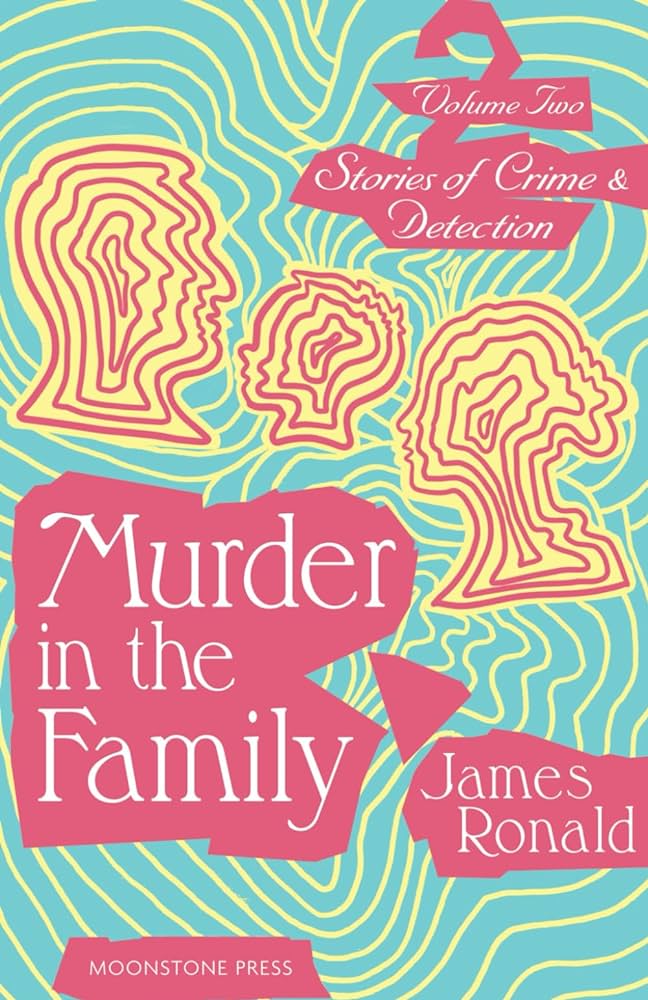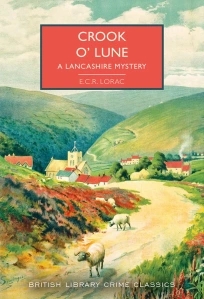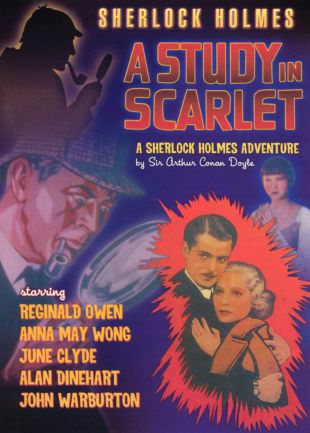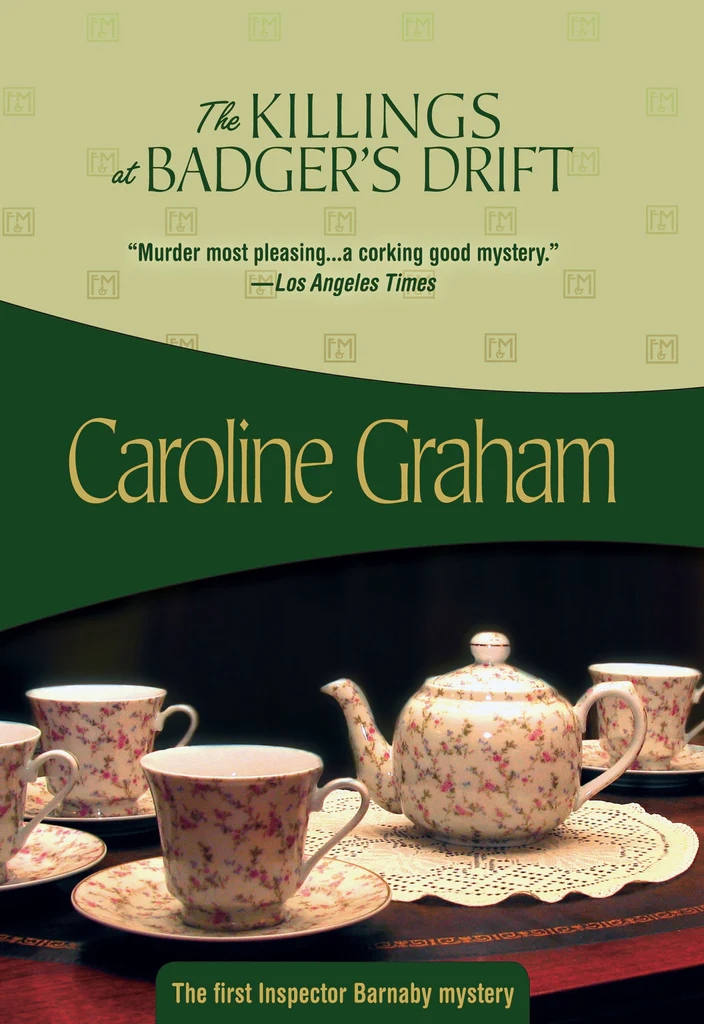
Originally published in 1936*.
Also published as The Murder in Gay Ladies.
* The edition shown has a publication date of 1931 on its copyright information page, but I believe 1936 is the correct date.
Stephen Osborne has lost his job and is worried about providing for his large family. He asks his wealthy sister for assistance, but Octavia Osborne is a most unpleasant person. She not only refuses to help but informs the family that she is writing them out of her will. Bad timing on her part; while sitting in their drawing room awaiting a train home, someone strangles Octavia. The police are convinced the murderer is a member of the Osborne household, and soon the whole town is in uproar.
It was JJ over at The Invisible Event who brought James Ronald to my attention a few months ago when he began talking about how Moonstone Press would be reprinting the writer’s complete works. I knew nothing about the writer but his enthusiasm in talking about this particular novel was infectious so I placed a pre-order and have been excitedly anticipating its release ever since. Well, it finally arrived on my doorstep late Friday and it took just one day to devour it – a promising start.
The story begins with Stephen Osborne, a man in his fifties with a large family, learning that his firm is restructuring and his position will be eliminated. He is aware that having no formal qualifications and being in the later stages of his career, finding a new position will be nearly impossible – especially as they only have a few months of savings to fall back on.
There is one hope: his much older sister Octavia who has a considerable fortune and no other dependents. Though their relationship has been frosty, Stephen hopes that she can be prevailed upon to help him by providing him with an income of a few hundred pounds a year to enable him to provide for his large family.
It does not go well and it is clear that help will not be forthcoming. Angry scenes between Octavia and Stephen’s family at lunch lead to the former announcing she will rewrite her will and she will be leaving to return to her own home. As the train will not arrive for several hours, she agrees to wait in the drawing room with Stephen’s younger daughter Ann who, rather than engaging with her aunt, prefers to read a book. When Ann is startled by a scream from Octavia’s companion Miss Mimms, she sees her aunt sitting dead in her chair, having apparently been strangled with a scarf.
Much of the setup for this novel will feel quite familiar. This is another example of the hated family member who manages to upset everyone in a short space of time and finds themselves bumped off. What sets this apart from other stories of that type however is that the members of that family aren’t at odds with each other but that they have largely warm and caring relationships with one another. Even the most roguish member of the family, Uncle Simon, is still portrayed quite warmly as a lovable, if unreliable sort, rather than a natural killer.
Not only are the suspects quite lovable, they all essentially have the same motive. If they did commit murder, it was to enable Steven to inherit his sister’s estate, preventing imminent financial disaster.
The main interest here is not so much the solution to the crime, but the exploration of how being at the center of an investigation affects this loving, close-knit family. Ronald does an excellent job of exploring their reactions to their situation, having their understanding of the horrors of their situation evolve both as they talk among themselves and realize how things are being perceived outside the household. As they come to recognize those dangers, their own behaviors change, presenting potential obstacles for the investigators (and the readers) to overcome to find the truth.
At around 200 pages, this is quite a short novel and it reads quite snappily, maintaining a strong pace throughout. Ronald does a very good job of parceling out small pieces of information regularly, ensuring that the story doesn’t become stagnant. We also quickly see the ingenuity of Ronald’s simple structure: each time we are relieved to find a character we like may have some piece of evidence that appears to clear them, we realize that by extension that makes it more likely that other characters we like may be accused or arrested.
Ronald is also incredibly good at conveying the horror of living with a scandal hanging over you. As detection stories are typically told from the perspective of the detective, the media elements of an investigation are not always a focus of mystery stories, but here they are of the utmost importance. Ronald not only demonstrates how stigma and gossip can build and become unbearable, but also that people’s interest in such scandals can be ghoulish. It’s impossible not to sympathize with each member of that household, perhaps in part because while Ronald illustrates those issues, he avoids drifting into melodrama.
In addition to the compelling cast of family members, Ronald presents us with a small cast of investigators who are similarly quite appealing. These characters are just as well drawn as the members of the family and their discussions about the case do an excellent job not only in recapping what has happened, but also in working through some of the implications of that information – both in terms of the investigation itself and also the characters’ experiences.
There are a few times where the investigation becomes quite comical, in spite of its obvious seriousness for the Osborne family. One of my favorite sequences involves an attempt by a policeman to conduct an interview with a potentially hostile source, only to find their plans go embarrassingly awry, while another is a beautifully well-observed conversation with an eyewitness. These lighter moments do a good job of providing balance to the darker aspects of the story, and because they each involve the discovery of important information, feel important to the overall narrative.
Turning to the book’s solution, I must say that I guessed the killer’s identity fairly early in this book in spite of some very effective misdirection. In other cases that might be a major mark against the book, but here I found I didn’t mind. That was partly because I was engaged in the question of what might happen to the various innocent characters I cared about, but also because I was keen to learn more about the sequence of events that made murder possible.
Overall, I was satisfied both by the killer’s identity and how the events of the final few chapters panned out. They were not only effective (and offer further opportunities for deduction on the part of the reader), I think that those developments fit neatly with the themes the writer has been developing throughout the novel.
Where I am disappointed however is in how quickly the story ends once the solution is provided. Having made the reader care about these characters and demonstrated how their lives have been upended, I wanted the reassurance in learning what became of those not guilty. While you might feel that this was not necessary and that the reader can guess at what follows, it didn’t give me the degree of closure I would have liked.
In addition to this novel, the Moonstone Press reprint includes two other short works. The Monocled Man is the more substantial of the two (though I’d still say it’s shorter than novella-length) while The Second Bottle is just a few pages long. Both stories are technically well-written and engaging, though the former is more of a pulpy crime story than a story of detection. I was glad to have them, but both feel like value added material rather than being features in their own right.
Overall, I was happy to say that my first experience of James Ronald’s writing was largely positive. Murder in the Family presents the reader with a compelling and dramatic situation, helped by its cast of sympathetic and relatively lovable suspects. I would gladly return to the writer again in the future and will no doubt be putting a volume or two of his work in my basket the next time I import some books from Blackwells.




Leave a comment